Related Research Articles
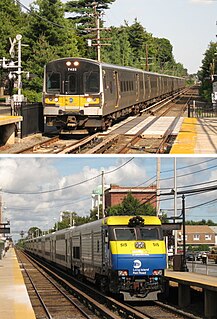
The Long Island Rail Road, often abbreviated as the LIRR, is a commuter rail system in the southeastern part of the U.S. state of New York, stretching from Manhattan to the eastern tip of Suffolk County on Long Island. With an average weekday ridership of 354,800 passengers in 2016, it is the busiest commuter railroad in North America. It is also one of the world's few commuter systems that runs 24/7 year-round. It is publicly owned by the Metropolitan Transportation Authority, which refers to it as MTA Long Island Rail Road.

Flushing–Main Street is the eastern terminal on the IRT Flushing Line of the New York City Subway, located at Main Street and Roosevelt Avenue in Downtown Flushing, Queens. It is served by the 7 local train at all times and the <7> express train during rush hours in the peak direction.

The New York and Atlantic Railway (NY&A) is a short line railroad formed in 1997 to provide freight service over the tracks of the Long Island Rail Road, a public commuter rail agency which had decided to privatize its freight operations. An affiliate of the Anacostia and Pacific Company, NY&A operates exclusively on Long Island, New York and is connected to the mainland via CSX's line over the Hell Gate Bridge. It also interchanges with New York New Jersey Rail's car float at the 65th Street Yard and US Rail of New York in Yaphank, New York. Its primary freight yard is Fresh Pond Junction in Queens. The NY&A officially took over Long Island Rail Road's freight operations on May 11, 1997. The initial franchise was for 20 years.

The IND World's Fair Line, officially the World's Fair Railroad, was a temporary branch of the Independent Subway System (IND) serving the 1939 New York World's Fair in Queens, New York City. It split from the IND Queens Boulevard Line at an existing flying junction east of Forest Hills–71st Avenue station, ran through the Jamaica Yard and then ran northeast and north through Flushing Meadows–Corona Park, roughly along the current path of the Van Wyck Expressway. The line continued along a wooden trestle to the World's Fair Railroad Station, located slightly south of Horace Harding Boulevard. The World's Fair station, the only one on the line, consisted of two tracks and three platforms.
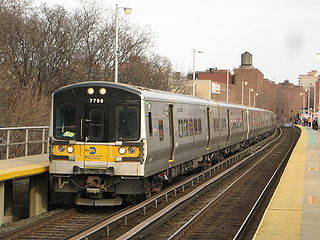
The Port Washington Branch is an electrified two-track rail line and service owned and operated by the Long Island Rail Road in the U.S. state of New York. It branches north from the Main Line at Winfield Junction, just east of the Woodside station in the New York City borough of Queens, and runs roughly parallel to Northern Boulevard past Mets-Willets Point, Flushing, Murray Hill, Broadway, Auburndale, Bayside, Douglaston, Little Neck, and then crosses into Nassau County for stops in Great Neck, Manhasset, and Plandome before terminating at Port Washington.

College Point is a working-middle-class neighborhood in the New York City borough of Queens. It is bounded to the south by Whitestone Expressway and Flushing; to the east by 138th Street and Malba/Whitestone; to the north by the East River; and to the west by Flushing Bay. College Point is a mostly residential ethnically diverse community with some industrial areas. The neighborhood is served by several parks and contains two yacht clubs.

The Flushing River, also known as Flushing Creek, is a waterway that flows northward through the borough of Queens in New York City, mostly within Flushing Meadows–Corona Park, emptying into the Flushing Bay and the East River. The river runs through a valley that may have been a larger riverbed before the last Ice Age, and it divides Queens into western and eastern halves. Until the 20th century, the Flushing Creek was fed by three tributaries: Mill Creek and Kissena Creek on the eastern bank, and Horse Brook on the western bank.

Francis Lewis Boulevard is a boulevard in the New York City borough of Queens. The roadway is named for Francis Lewis, a Queens resident who was a signer of the United States Declaration of Independence. The boulevard zigzags across several physical roadways and intersects itself at a 90-degree angle multiple times.
The North Shore Bus Company operated public buses in Queens, New York City. It was established in 1920 as the successor to the New York and North Shore Traction Company trolley system, and operated until 1947 when it went bankrupt, and its operations were taken over by the New York City Board of Transportation.

The Whitestone Branch was a branch of the Long Island Rail Road, running north and east along the left bank of the Flushing River from the Port Washington Branch near the modern Willets Point/Flushing sections of Queens, New York. It crossed the river on one of the three bridges that were later torn down for the Van Wyck Expressway, then ran north along Flushing Bay and east along the East River to Whitestone.
The Long Island Rail Road is a railroad owned by the Metropolitan Transportation Authority in the U.S. state of New York. It is the oldest United States railroad still operating under its original name and charter. It consolidated several other companies in the late 19th century. The Pennsylvania Railroad owned the Long Island Rail Road for the majority of the 20th century and sold it to the State in 1966.
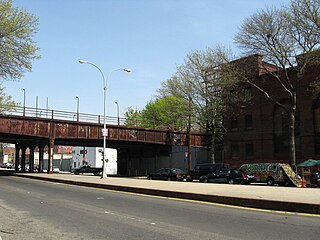
The Rockaway Beach Branch was a rail line owned and operated by the Long Island Rail Road in Queens, New York City, United States. The line left the Main Line at Whitepot Junction in Rego Park heading south via Ozone Park and across Jamaica Bay to Hammels in the Rockaways, turning west there to a terminal at Rockaway Park. Along the way it connected with the Montauk Branch near Glendale, the Atlantic Branch near Woodhaven, and the Far Rockaway Branch at Hammels.

Woodhaven Junction was a station complex on the Atlantic Branch and Rockaway Beach Branch of the Long Island Rail Road, located at Atlantic Avenue between 98th and 100th Streets in Woodhaven, Queens, New York City. The elevated Rockaway Beach station was closed in 1962 along with the rest of the branch, while the underground Atlantic Branch station was closed and abandoned on January 7, 1977.
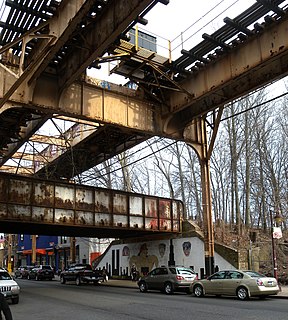
Brooklyn Manor was a station on the Long Island Rail Road's Rockaway Beach Branch located on the south side of Jamaica Avenue at 100th Street, straddling the border between Richmond Hill and Woodhaven in Queens, New York City. The station name referred to the nearby Brooklyn Manor section of Woodhaven, originally a 603-lot development bounded by Woodhaven Boulevard to the west, 96th/98th Streets to the east, Forest Park to the north, and Jamaica Avenue to the south. The station opened in January 1911, and was constructed as a replacement for the Brooklyn Hills station, which was located 3,000 feet (910 m) to the north. This station closed along with the rest of the Rockaway Beach Branch in 1962, and was subsequently demolished.
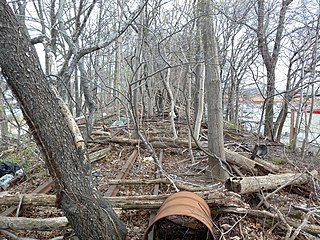
Parkside is a former elevated Long Island Rail Road (LIRR) station on the north side of Metropolitan Avenue on the border of the Rego Park, Forest Hills, and Glendale neighborhoods in Queens, New York City. Opened in 1927, the wooden station was part of the Rockaway Beach Branch and was the northernmost station on the branch before the junction with the Main Line at Rego Park Station and the terminus of the line at Grand Street station in Elmhurst. It also had a connecting spur to the Montauk Branch east towards Richmond Hill station. The station was closed in 1962, twelve years after the LIRR had abandoned the Rockaway portions of the line.

The Evergreen Branch was a branch of the Long Island Rail Road (LIRR) that ran in Brooklyn and part of Queens in New York City. The line, at its fullest extent, ran between Greenpoint, Brooklyn and Ridgewood, Queens. The line consisted of two leased portions. The first portion, between Greenpoint and Jefferson Avenue, was leased from the Glendale and East River Railroad. The second portion, from Jefferson Avenue to Ridgewood, was leased from the Brooklyn and Rockaway Beach Railroad Company, and was known as the Evergreen Branch, a name later extended to the rest of the line.

The Bushwick Branch, also called the Bushwick Lead Track, is a freight railroad branch in New York City. It runs from Bushwick in Brooklyn to Fresh Pond Junction in Maspeth, Queens, where it connects with the Montauk Branch of the Long Island Rail Road. It is owned by the LIRR but operated under lease by the New York and Atlantic Railway, which took over LIRR freight operations in May 1997.
Central Railroad of Long Island was built on Long Island, New York, by Alexander Turney Stewart, who was also the founder of Garden City. The railroad was established in 1871, then merged with the Flushing and North Side Railroad in 1874 to form the Flushing, North Shore and Central Railroad. It was finally acquired by the Long Island Rail Road in 1876 and divided into separate branches. Despite its short existence, the CRRLI had a major impact on railroading and development on Long Island.
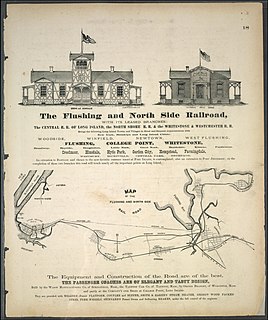
The Flushing and North Side Railroad was a former railroad on Long Island built by Conrad Poppenhusen as a replacement for the former New York and Flushing Railroad. The railroad was established in 1868, was merged with the Central Railroad of Long Island in 1874 to form the Flushing, North Shore and Central Railroad, and was finally acquired by the Long Island Rail Road in 1876. Today the main line is known as the Port Washington Branch of the Long Island Rail Road.

Whitestone Landing was the terminal station on the Whitestone Branch from its opening on August 9, 1886, to the Whitestone Branch's abandonment in February 1932. In June 1892 the station was moved back from the shoreline. On February 15, 1932, the Whitestone Branch was abandoned and all stations on the branch closed.
References
- Walsh, Kevin “College Point, Queens” May 2006 Forgotten-NY forgotten-ny.com/2006/05/college-point-queens/
- Poppenhusen Institute poppenhuseninstitute.org/history/
- “Offers to give city Whitestone Branch” New York Times July 14, 1926
- “State acts to save Whitestone Branch” New York Times May 4, 1930
- “Argues for retaining Whitestone Branch” New York Times Nov. 25, 1931
- “Contractor buys Whitestone Spur” New York Times April 26, 1932
- “Action by City on Whitestone line Unlikely. Railroadless townsmen get no encouragement from Estimate Board” Brooklyn Daily Eagle Feb. 24, 1932.
- “Long battle in courts marked attempts to halt Whitestone abandonment” Brooklyn Daily Eagle Jan. 5, 1932